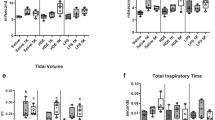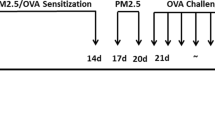Abstract
The effects of components of ambient particulate matter (PM) on individuals with predisposing respiratory disorders are not well defined. We have previously demonstrated that airway exposure to diesel exhaust particles (DEP) or organic chemicals (OC) extracted from DEP (DEP–OC) enhances lung inflammation related to bacterial endotoxin (lipopolysaccharide, LPS). The present study aimed to examine the effects of airway exposure to OC extracted from urban PM (PM–OC) on lung inflammation related to LPS. ICR mice were divided into four experimental groups that intratracheally received vehicle, LPS (2.5 mg/kg), PM–OC (4 mg/kg), or PM–OC + LPS. Lung inflammation, lung water content, and lung expression of cytokines were evaluated 24 h after intratracheal administration. LPS challenge elicited lung inflammation evidenced by cellular profiles of bronchoalveolar lavage fluid and lung histology, which was further aggravated by the combined challenge with PM–OC. The combination with PM–OC and LPS did not significantly exaggerate LPS-elicited pulmonary edema. LPS instillation induced elevated lung expression of interleukin-1β, macrophage inflammatory protein-1α, macrophage chemoattractant protein-1, and keratinocyte chemoattractant, whereas the combined challenge with PM–OC did not influence these levels. All the results were consistent with our previous reports on DEP–OC. These results suggest that the extracted organic chemicals from PM exacerbate infectious lung inflammation. The mechanisms underlying the enhancing effects are not mediated via the enhanced local expression of proinflammatory cytokines.

Similar content being viewed by others
References
Appay V, Rowland-Jones SL (2001) RANTES: a versatile and controversial chemokine. Trends Immunol 22:83–87
Batalha JR, Saldiva PH, Clarke RW, Coull BA, Stearns RC, Lawrence J, Murthy GG, Koutrakis P, Godleski JJ (2002) Concentrated ambient air particles induce vasoconstriction of small pulmonary arteries in rats. Environ Health Perspect 110:1191–1197
Becker S, Soukup JM, Sioutas C, Cassee ER (2003) Response of human alveolar macrophages to ultrafine, fine, and coarse urban air pollution particles. Exp Lung Res 29:29–44
Clarke RW, Catalano PJ, Koutrakis P, Murthy GG, Sioutas C, Paulauskis J, Coull B, Ferguson S, Godleski JJ (1999) Urban air particulate inhalation alters pulmonary function and induces pulmonary inflammation in a rodent model of chronic bronchitis. Inhal Toxicol 11:637–656
Dockery DW, Pope CA III, Xu X, Spengler JD, Ware JH, Fay ME, Ferris BG Jr, Speizer FE (1993) An association between air pollution and mortality in six US cities. N Engl J Med 329:1753–1759
Ford-Hutchinson AW, Bray MA, Doig MV, Shipley ME, Smith MJ (1980) Leukotriene B, a potent chemokinetic and aggregating substance released from polymorphonuclear leukocytes. Nature 286:264–265
Ghio AJ, Huang YC (2004) Exposure to concentrated ambient particles (CAPs): a review. Inhal Toxicol 16:53–59
Ghio AJ, Hall A, Bassett MA, Cascio WE, Devlin RB (2003) Exposure to concentrated ambient air particles alters hematologic indices in humans. Inhal Toxicol 15:1465–1478
Gordon T, Nadziejko C, Chen LC and Schlesinger R (2000) Effects of concentrated ambient particles in rats and hamsters: an exploratory study. Res Rep Health Eff Inst 5–34; discussion 35–42
Guo RF, Ward PA (2005) Role of C5a in inflammatory responses. Annu Rev Immunol 23:821–852
Hirano S, Furuyama A, Koike E, Kobayashi T (2003) Oxidative-stress potency of organic extracts of diesel exhaust and urban fine particles in rat heart microvessel endothelial cells. Toxicology 187:161–170
Huang YC, Ghio AJ, Stonehuerner J, McGee J, Carter JD, Grambow SC, Devlin RB (2003) The role of soluble components in ambient fine particles-induced changes in human lungs and blood. Inhal Toxicol 15:327–342
Ichinose T, Furuyama A, Sagai M (1995) Biological effects of diesel exhaust particles (DEP). II. Acute toxicity of DEP introduced into lung by intratracheal instillation. Toxicology 99:153–167
Ichinose T, Takano H, Miyabara Y, Sagai M (1998) Long-term exposure to diesel exhaust enhances antigen-induced eosinophilic inflammation and epithelial damage in the murine airway. Toxicol Sci 44:70–79
Kodavanti UP, Mebane R, Ledbetter A, Krantz T, McGee J, Jackson MC, Walsh L, Hilliard H, Chen BY, Richards J, Costa DL (2000) Variable pulmonary responses from exposure to concentrated ambient air particles in a rat model of bronchitis. Toxicol Sci 54:441–451
Kumagai Y, Taira J, Sagai M (1995) Apparent inhibition of superoxide dismutase activity in vitro by diesel exhaust particles. Free Radic Biol Med 18:365–371
McClellan RO (1987) Health effects of exposure to diesel exhaust particles. Annu Rev Pharmacol Toxicol 27:279–300
Miyabara Y, Yanagisawa R, Shimojo N, Takano H, Lim HB, Ichinose T, Sagai M (1998) Murine strain differences in airway inflammation caused by diesel exhaust particles. Eur Respir J 11:291–298
Samet JM, Dominici F, Curriero FC, Coursac I, Zeger SL (2000) Fine particulate air pollution and mortality in 20 US cities, 1987–1994. N Engl J Med 343:1742–1749
Schins RPF, Lightbody JH, Borm PJA, Shi T, Donaldson K, Stone V (2004) Inflammatory effects of coarse and fine particulate matter in relation to chemical and biological constituents. Toxicol Appl Pharmacol 195:1–11
Schwartz J (1994) Air pollution and daily mortality: a review and meta analysis. Environ Res 64:36–52
Schwartz J, Dockery DW, Neas LM (1996) Is daily mortality associated specifically with fine particles? J Air Waste Manag Assoc 46:927–939
Smith KR, Kim S, Recendez JJ, Teague SV, Menache MG, Grubbs DE, Sioutas C, Pinkerton KE (2003) Airborne particles of the California central valley alter the lungs of healthy adult rats. Environ Health Perspect 111:902–908
Speyer CL, Gao H, Rancilio NJ, Neff TA, Huffnagle GB, Vidya Sarma J, Ward PA (2004) Novel chemokine responsiveness and mobilization of neutrophils during sepsis. Am J Pathol 165:2187–2196
Takano H, Yoshikawa T, Ichinose T, Miyabara Y, Imaoka K, Sagai M (1997) Diesel exhaust particles enhance antigen-induced airway inflammation and local cytokine expression in mice. Am J Respir Crit Care Med 156:36–42
Takano H, Ichinose T, Miyabara Y, Yoshikawa T, Sagai M (1998) Diesel exhaust particles enhance airway responsiveness following allergen exposure in mice. Immunopharmacol Immunotoxicol 20:329–336
Takano H, Yanagisawa R, Ichinose T, Sadakane K, Yoshino S, Yoshikawa T, Morita M (2002) Diesel exhaust particles enhance lung injury related to bacterial endotoxin through expression of proinflammatory cytokines, chemokines, and intercellular adhesion molecule-1. Am J Respir Crit Care Med 165:1329–1335
Trottein F, Faveeuw C, Gosset P, Angeli V (2004) Role of the D prostanoid receptor 1 in the modulation of immune and inflammatory responses. Crit Rev Immunol 24:349–362
Ulich TR, Yin SM, Guo KZ, del Castillo J, Eisenberg SP, Thompson RC (1991) The intratracheal administration of endotoxin and cytokines. III. The interleuikin-1 (IL-1) receptor antagonist inhibits endotoxin- and IL-1 induced acute inflammation. Am J Pathol 138:521–524
Urch B, Brook JR, Wasserstein D, Brook RD, Rajagopalan S, Corey P, Silverman F (2004) Relative contributions of PM2.5 chemical constituents to acute arterial vasoconstriction in humans. Inhal Toxicol 16:345–352
Van Damme J, Wuyts A, Froyen G, Van Coillie E, Struyf S, Billiau A, Proost P, Wang JM, Opdenakker G. (1997) Granulocyte chemotactic protein-2 and related CXC chemokines: from gene regulation to receptor usage. J Leukoc Biol 62:563–569
Yanagisawa R, Takano H, Inoue K, Ichinose T, Sadakane K, Yoshino S, Yamaki K, Kumagai Y, Uchiyama K, Yoshikawa T, Morita M (2003) Enhancement of acute lung injury related to bacterial endotoxin by components of diesel exhaust particles. Thorax 58:605–612
Yanagisawa R, Takano H, Inoue K, Ichinose T, Sadakane K, Yoshino S, Yamaki K, Yoshikawa T, Hayakawa K (2006) Components of diesel exhaust particles differentially affect Th1/Th2 response in a murine model of allergic airway inflammation. Clin Exp Allergy 36:386–395
Author information
Authors and Affiliations
Corresponding author
Rights and permissions
About this article
Cite this article
Inoue, Ki., Takano, H., Yanagisawa, R. et al. Effects of organic chemicals derived from ambient particulate matter on lung inflammation related to lipopolysaccharide. Arch Toxicol 80, 833–838 (2006). https://doi.org/10.1007/s00204-006-0105-1
Received:
Accepted:
Published:
Issue Date:
DOI: https://doi.org/10.1007/s00204-006-0105-1




